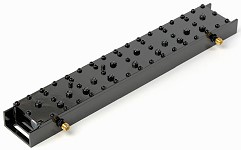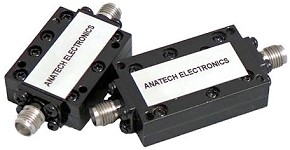|

Anatech Electronics, an RF and microwave filter company, has introduced a new
line of suspended stripline and waveguide type RF filters. Also, Sam Benzacar wrote
as part of his May newsletter an article entitled "Wi-fi Marches Forward, Unnoticed,"
which focuses on how advances in Wi-Fi are being made to address contemporary needs,
while the news industry and subsequently users are largely unaware of the changes.
802.11ax, rebranded as Wi-Fi 6 by the Wi-Fi Alliance, provides data rate increases
up to 37% over 802.11ac. Increased range and higher device connection counts, needed
to cover large venues without extenders, is a big part of the performance enhancement.
Other news items include 5G interference with weather satellites, NB-IoT rollouts,
and the SpaceX satellite cluster launch.
A Word from Sam Benzacar
 Wi-Fi Marches
Forward, Unnoticed
By Sam Benzacar
With 5G getting all the attention, Wi-Fi seems to have taken a back seat, accepted
by everyone as a commodity we can't live without but not advancing much from a technological
perspective. However, Wi-Fi is moving forward nicely in lockstep with 5G and lots
of interesting advances are taking place that will propel this technology's capabilities
impressively.
The most obvious of these has been the need to extend Wi-Fi range to cover large
homes and other areas, which was first accomplished by range extenders that take
the existing signal from the router and rebroadcast it. The problem with this approach
is that the signal strength from the range extender is directly related to what
it receives, so if the input signal is weak, data rates decrease.
The next solution is mesh networking capabilities, which all other short-range
communications solutions have as a necessity if they're to serve IoT applications.
Unlike range extenders, mesh networks don't require every node to connect directly
to the router (a star topology) but rather to each other (in a mesh). In addition
to mostly solving the signal strength problem, Wi-Fi mesh networks can be scaled
to cover a very large area. I own one of these systems and it works very well.
The next advance is 802.11ax that the Wi-Fi Alliance has rebranded as Wi-Fi 6,
which increases downstream data rates by 37% versus 802.11ac and is supported by
some routers and will be standard in the next crop of smartphones. The rebranding
was long overdue, and it is beginning to apply to its predecessors as well (a bit
too late, unfortunately), to simplify what has become an alphabet soup of variations
in the standards.
However, speed isn't the biggest benefit of Wi-Fi 6. It's the ability to serve
more dense device environments more effectively, in response to the huge number
of Wi-Fi-enabled devices in many locations. Another feature of Wi-Fi 6 is deterministic
scheduling that takes the place of the listen-before-talk approach to interference
mitigation and uses the same MAC layer as cellular so handoffs between the two services
should be much better. And like 5G, Wi-Fi 6 also has lower latency and uses the
OFDMA architecture, which provides other benefits as well.
One of the biggest problems with wireless services operating in unlicensed ISM
bands is interference, and even though Bluetooth, Wi-Fi, and other services inherently
act to reduce it, the current 2.4 GHz and 5 GHz allocations are overflowing. The
good news is that the FCC has added some new channels at 5 GHz and is adding even
more at 6 GHz, possibly 120 MHz of bandwidth, which would open entirely new possibilities
for Wi-Fi.
Another interesting development is the incorporation of the shared Citizens Band
Radio Service (CBRS) frequencies around 3.5 GHz into Wi-Fi solutions, effectively
merging unlicensed (Wi-Fi) and licensed (CBRS) services. Products from companies
such as Commscope and Cisco are already addressing this. If Licensed Assisted Access
(LAA) frequencies, Wi-Fi, and CBRS come together in some form, an entirely new class
of service would be created.
Finally, there's 802.11ad (Wi-Gig) and 802.11ay that operate at 2.4, 5, and 60
GHz to deliver downstream rates of nearly 7 Gb/s. The 60-GHz component adds lots
of bandwidth usable over very short distances while the lower frequencies serve
traditional applications. Taken together, all these advances are turning Wi-Fi into
a formidable, collaborative service whose applications will range far beyond what
they are today. Stay tuned.
 Feds: 5G Bad for Weather Forecasting Feds: 5G Bad for Weather Forecasting
While the FCC continues to auction spectrum at 24 GHz for 5G networks, NASA,
NOAA, and the Navy are continuing their mission to keep it from causing interference.
Their stated reason is that emissions at 24 GHz will interfere with the satellite-based
measurements of atmospheric water vapor made at frequencies just below those being
auctioned. A Navy memo to the FCC noted that "it is expected that interference will
result in a partial-to-complete loss of remotely sensed water-vapor measurements
and could affect Navy and Marine Corps forecasts of tropical cyclones as well as
rain, ice, and snow." The affected agencies want the FCC to rule that out-of-band
interference limits will be tightened to -57 dBm.
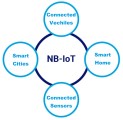 Carriers Rolling out NB-IoT Carriers Rolling out NB-IoT
Sprint is testing narrowband IoT (NB-IoT) technology and will deploy it if there
is customer demand, while AT&T has launched NB-IoT throughout its network. T-Mobile
also has a nationwide NB-IoT network, and Verizon earlier began to deploy NB-IoT
in the guard bands next to its LTE-M network. Dish Networks is also planning to
deploy an NB-IoT network and is currently working on deals with vendors.
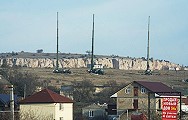 Pravda: Russia ups EW Against Europe Pravda: Russia ups EW Against Europe
The Russian news outlet Pravda recently reported that the country has deployed
EW systems in its Baltic Fleet Kaliningrad that are designed to disrupt communication
between warships, aircraft and ground military units in Eastern and Central Europe,
as well as in the Baltic region at a maximum distance of 1,864 miles. The "Murmansk-BN"
jammer is targeted at high frequency communications systems, including the High
Frequency Global Communications System. The HFGCS is a worldwide network of transmitters
which provides command and control communications between ground agencies and US
military aircraft and ships.
 NEXRAD Upgrades at Halfway Point NEXRAD Upgrades at Halfway Point
The eight-year plan for upgrading the 25-year-old U.S. NEXRAD weather radar network
has reached the midpoint. The National Weather Service, Air Force, and FAA are funding
the $150 million to refurbish 159 stations, with an expected completion date of
2023. Upgrades include signal processing and computing power, as well as refurbishing
transmitters and the pedestals on which the radar antennas rotate.
 SpaceX Launches First Broadband Satellites SpaceX Launches First Broadband Satellites
Elon Musk, never one to "go small" has initiated its first efforts to provide
broadband from space, with the launch by SpaceX of 60 of its Starlink satellites
from Cape Canaveral (note their dense packing in the spacecraft). That's just the
beginning though, as the plan is to have up to 12,000 of them in geostationary orbit,
presumably making inexpensive service available anywhere. That would be good news
for the more than 20 million people in the U.S. and far more elsewhere who still
have nothing approaching decent Internet access.
Anatech Electronics Introduces a New Line of Suspended Stripline and
Waveguide Type RF Filters
Anatech Electronics Introduces a New Line of Suspended Stripline and
Waveguide Type RF Filters
Check out Our Filter Products
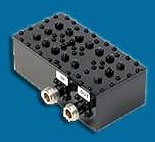
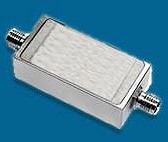

Cavity Band Pass Filters
LC Band Pass Filters Cavity Bandstop/Notch Filter
About Anatech Electronics
Anatech Electronics, Inc. (AEI) specializes in the design and manufacture of
standard and custom RF and microwave filters and other passive components and subsystems
employed in commercial, industrial, and aerospace and applications. Products are
available from an operating frequency range of 10 kHz to 30 GHz and include cavity,
ceramic, crystal, LC, and surface acoustic wave (SAW), as well as power combiners/dividers,
duplexers and diplexers, directional couplers, terminations, attenuators, circulators,
EMI filters, and lightning arrestors. The company's custom products and capabilities
are available at www.anatechelectronics.com.
Contact:
Anatech Electronics, Inc. 70 Outwater Lane Garfield, NJ 07026 (973)
772-4242
sales@anatechelectronics.com
Posted May 22, 2019
|











 Feds: 5G Bad for Weather Forecasting
Feds: 5G Bad for Weather Forecasting Carriers Rolling out NB-IoT
Carriers Rolling out NB-IoT  Pravda: Russia ups EW Against Europe
Pravda: Russia ups EW Against Europe NEXRAD Upgrades at Halfway Point
NEXRAD Upgrades at Halfway Point SpaceX Launches First Broadband Satellites
SpaceX Launches First Broadband Satellites